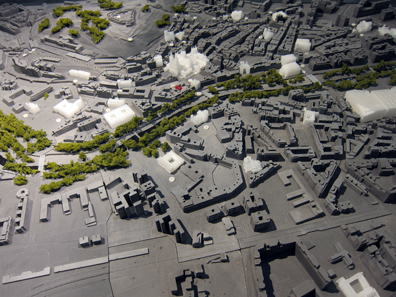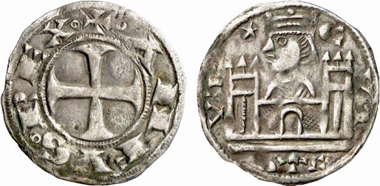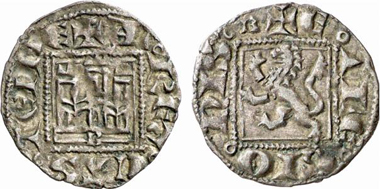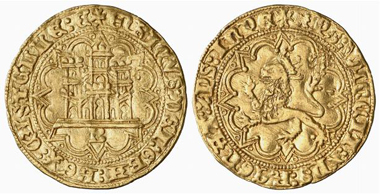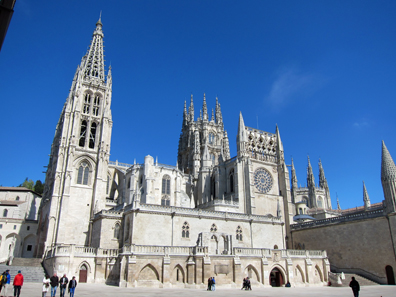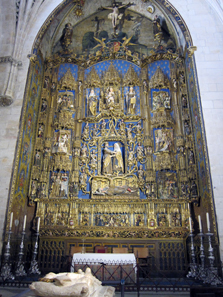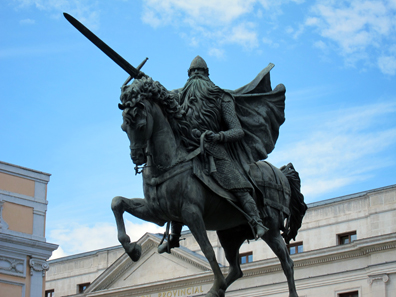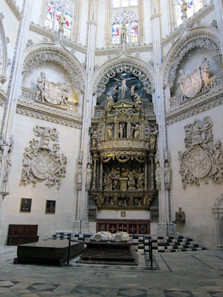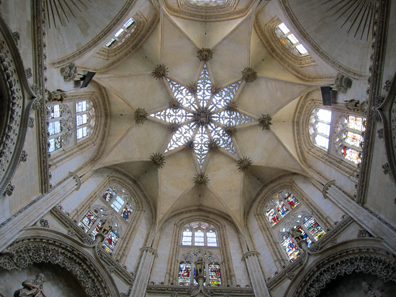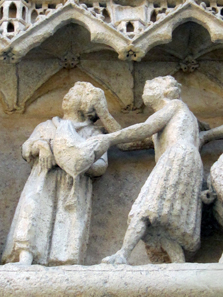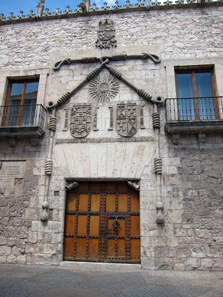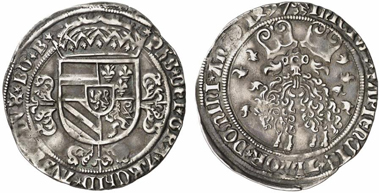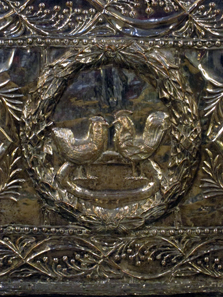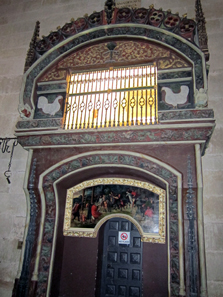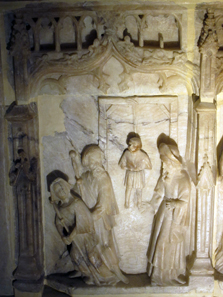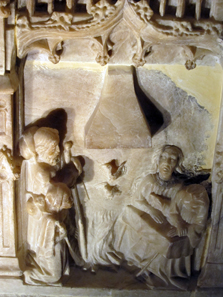by Ursula Kampmann
November 22, 2012 – After a long pause, we’re back with another chapter of our little numismatic trip through Spain. Today we’re visiting Burgos, an important minting site of the Castilian kings. Then it’s on to Santo Domingo de la Calzada, known for the fact that its roast chickens occasionally have a tendency to come back to life!
Tuesday April 17, 2012
It was freezing cold and the sun was beaming as we set off from the parador in Leon to cover yet another leg of the Way of St. James in reverse order. Our next destination was Burgos, arguably one of the most famous cities in Northern Spain.
City map of modern Burgos, in the downstairs of the tourist office. Photo: KW.
Today, Burgos is still an affluent and active commercial city with a sprawling retail centre. It’s also one of the most important tourist centres in northern Spain, something that we were certainly happy about. The city centre was wonderfully signed, as was the convenient parking garage. And the cathedral was big enough that it was easy to find straight off the bat.
Alfonso VIII, 1158-1214. Dinero, Cuenca(?). From Künker 137 (2008), 3422.
Burgos was founded in the year 884 by Alfonso III as one of many fortresses, or castle villages, which give the region its name: Castille. They served as a safeguard against the Arabs and, through their depiction on Castilian coins, became a symbol of the kingdom.
Initially, however, Burgos was a part of the Kingdom of Leon, and since about 930, the capital of a Castilian Duchy. In the 11th century, the city became the seat of a bishop and also the city where Castilian kings were crowned. Moreover, this merchant city, which exported wool and flax to England, was also an important stop on the Way of St. James.
Sancho IV, 1284-1295. Cornado, Burgos. From Künker 137 (2008), 3434.
During the 13th and 14th centuries, Burgos was the preferred residence of the kings of Castille and Leon. The city also became a sort of testing ground for policy and for the kings to see just to what extent they could narrow and restrict the rights of their subjects. There was a very active middle class in Burgos, and some of the families had amassed great wealth. These families wanted a say in the spending of their taxes. Sancho IV leveraged their demands and established a new body, the ‘jurado,’ which was charged with collecting taxes and overseeing public works. Obviously, the citizens were not pleased.
Alfonso XI, 1312-1350. Noven, Burgos. From Künker 137 (2008), 3442.
This led to uprisings that were put to an end by Alfonso XI in 1345 when he established direct royal rule in Burgos. This was to be carried out by a council whose 16 members were personally appointed by the king.
Henry IV, 1454-1474. Castellano, Burgos. From Künker 117 (2006), 5570.
At the request of Philip II, Pope Gregory XIII made Burgos into an archdiocese. By this point, however, the city’s importance had already waned – Madrid and more southern-lying cities had superseded Burgos as centres of trade. Burgos would merely come to play a role in history now and then, like when in 1812 the troops of British general Wellington besieged the French occupation of the city, but did not succeed in capturing Burgos. Or during the Spanish Civil War, when Burgos served as an important base for Franco’s Nationalists.
The Arco de Santa Maria with the statues of the Spanish kings. Photo: KW.
We entered the old town through the Arco de Santa Maria, which was completed in 1535 as a stone-based symbol of the surrender of the ‘comuneros.’
In 1516, Ferdinand II of Aragon died childless. He left the throne to Charles I, better known to us as Charles V, the eldest son of Ferdinand’s sister Johanna (the Mad). Not only was Charles born in Flanders, he was also raised there. As such, Spain was a foreign nation to him that at most served to finance his war with France. It’s no wonder that the Spaniards were incensed, and in 1520, uprisings started in Toledo. The comuneros rescued Johanna, Charles’ mother, and made her their ruler. She turned out to be unhelpful, however, and as soon as Charles managed to get his hands on her, was immediately locked up in a monastery.
Charles V, 1506-1555. Real d’oro, Antwerp. From Künker 221 (2012), 8004.
In the meantime, the revolt had gotten out of control. The peasants and civil lower classes had seen this as a welcome opportunity to try to improve their small lot in life somewhat, much to the anger of the nobility who, for the most part, opted to come to an arrangement with Charles. On April 23, 1521, Charles won the decisive victory, but it would still take some time before the last of the insurgents were finally accounted for. Structures remained throughout the country showing the subjugated displaying their reverence to the victor, much like this Arco de Santa Maria.
The Cathedral of Burgos. Photo: KW.
It’s just a few steps from the arch of triumph to the cathedral. It’s the city’s most important tourist attraction, a magnificent Gothic structure that has been a Unesco World Heritage Site since as far back as 1984. This status is also reflected in the admission price – tourists pay 7 EUR, while pilgrims with official pilgrim’s identity cards pay 3.50.
The altar of the Immaculate Conception in the Conception chapel. Photo: KW.
Unfortunately the entrance ticket seems to give many visitors the feeling that they’re in a museum rather than a church, and can thus behave as such. We had to contend with a Dutch tour group that day whose members felt the need to call out commentary to one another at the top of their voices. It was something we really could have done without.
The tomb of El Cid and his wife, Jimena. Photo: KW.
At this point I so would have loved to revel in my childhood memories of the film ‘El Cid’ with Charlton Heston. The Campeador is in fact buried in the Cathedral of Burgos, together with his wife, Jimena.
What a lovely image that was, watching the lifeless body of the Cid tied to a horse riding into the sunset. It’s too bad though that the film really has very little bearing on reality: Rodrigo Diaz de Vivar, the Cid, was born in 1043 about seven kilometres from Burgos. Following the death of his father, the 15-year-old Cid came to the royal court and was educated there. After the division of the empire in 1065, Rodrigo remained with Sancho II, who conquered Castille, and then with his brother Alfonso VI following his death.
Spain. 200 Euro 2007. From Gorny & Mosch / BW Bank 1 (2010), 1432.
Rodrigo had been the standard-bearer in Sancho’s court, but was then usurped. Affronted, the Cid headed out on his own to fight against and also with the Moors and, at a favourable opportunity, was able to capture his rivals in rather humiliating fashion. The king was angry and banished Rodrigo, who sought out a new master, offering his services to the ruler of Saragossa, al-Mu’tamin. Under his official orders, the knight assembled a robber band whose very lucrative raids brought more and more men under his command. In 1094, during the chaos that followed the invasion of the Almoravids, the Cid even succeeded in bringing the once Muslim city of Valencia under his control.
It was to have been a formidable regiment (at least according to his rivals). The new head of church of Spain, however, a hardliner appointed by Bernhard von Clairveaux, praised the campeador for his staunch refusal to compromise.
Statue of the Cid in Burgos. Photo: KW.
The Cid died in 1099 – peacefully in bed, most likely. But the epic poem made his passing into a heroic death: the dying man had his knights take an oath to attack the enemy with his body at the lead. The dead man was placed atop his loyal stallion, his sword strapped to his hand, and away they went. Of course, it was to be an amazing victory!
In actual fact, the body and his widow had to be brought to safety by Alfonso VI in 1102. This is why the Cid lies buried today in Burgos. It was literature that first made him into a hero, and no piece more so than the epic poem ‘el cantar de mio cid,’ which has no more truth to it than the 1961 Hollywood blockbuster that I had been so taken with.
The Capilla del Condestable. Photo: KW.
If you thought, however, that the tomb of the Cid was the absolute highlight of the Cathedral of Burgos, you’d be sorely mistaken. In the Capilla del Condestable, the ethnic German architect Simon of Cologne really created a true late Gothic masterpiece.
Taking a look into the cupola of the Capilla del Condestable. Photo: KW.
The enchanting tracery looks like lace. The fineness and delicate craftsmanship of the carvings in the chapel are beyond compare.
Detail of the Portal of San Nicola – A rich man is weighed down by his bag of money and being led away by a devil. Photo: KW.
We ended up staying at the Cathedral of Burgos for well over two hours, and by the time we left, everything else was already closed. A quick walk through the city showed us many fine details like, for example, a tableau depicting a scene from hell on the San Nicola church showing a rich man, his thick bag of money around his neck. It was cold though, and so we decided to go have a bite to eat. Unluckily enough, we managed to pick the exact same restaurant as the Dutch tour group who stormed in noisily before we’d barely had a chance to order. Suffice it to say, it wasn’t the quietest meal that we enjoyed in Spain.
Entrance to the Casa del Cordón. Photo: KW.
We were still a bit annoyed after our meal, but made one more excursion to the Casa del Cordón, whose entranceway is adorned by the rope that the Franciscans normally wear around their waists.
Philip the Fair, 1478-1506. Toison d’argent 1497, Antwerp. From Künker 217 (2012), 2036.
This house is of particular historical significance since it’s here that Philip the Fair died in 1506 after a heated game of pelota. It was a fever that did him in. He left behind a young wife who was driven to madness following his death. However, it remains questionable just to what extent her deep sorrow was accommodating to the political establishment, in that she presented no competition to her son Charles I.
We left the parking garage, determined to visit a few more of the famous monasteries of Burgos. But here, somehow, our guidebook had been mislaid. We were already out of the city by the time we realized it had gone missing. Just as well, we really had seen enough already.
What are two roosters doing in a church? Photo: KW.
Our next stop was the parador of Santo Domingo de la Calzada, which seems like it should be easy to find, one might think. This little town on the pilgrims’ path is not actually very big, but finding our chosen accommodation for the night was not as easy as it seemed! After we’d followed the signs, we arrived in front of the wrong parador. Turns out that in Santo Domingo, there are actually two of them.
A chicken cage in the cathedral – with live chickens!!! Photo: KW.
Although slightly annoyed, we managed to find the right parador and then decided to go have a look at the local cathedral. It certainly had something we’d never seen before: right in the middle of the church was a gigantic chicken cage.
St. Domingo holds up the hanged. Photo: KW.
The reason for the chickens can be traced back to a legend that’s also quite well known in these parts. A German family, father, mother and son, were on pilgrimage towards St. James. The devout family spent the night in Santo Domingo. While at the inn, however, one of the host’s brash young daughters developed something of a crush on the young man. When he flat out rejected her advances, she vowed revenge. She tucked one of the silver plates into his things and then accused him the next morning of having stolen it. The accused was found guilty, of course, and was hanged. His parents continued along their journey, wracked with sorrow.
When they returned from Santiago, they arrived to find their son hanging at the gallows, rosy and alive. He greeted them cheerfully and told them he had stood upon the shoulders of St. Domingo so that he’d had enough air to breathe and so his weight might be supported. He also told his parents to inform the head judge immediately so that he could be released from the gallows.
The miracle of the chickens. Photo: KW.
No sooner said than done. But the high city official had just sat down to eat and didn’t want to be disturbed. He thought the parents were crazy and told them that their son was as alive as the roast chickens on his plate, at which point, much to his great surprise, the creatures sprouted feathers and flew away.
Apparently, there are still descendants of these chickens living in Santo Domingo de la Calzada. Incidentally – and this should be of some consolation for all animal lovers – they are exchanged at short, regular intervals for other descendants of the roasting chickens.
And that was enough for one day. In the next chapter, we’ll visit a couple of famous sites along the Way of St. James, the Templar church Eunate and Puenta la Reina. We’ll also take a look at the graves of the Kings of Navarra in the rock-hewn monastery of Najera.
You can read all other parts of this diary here.




